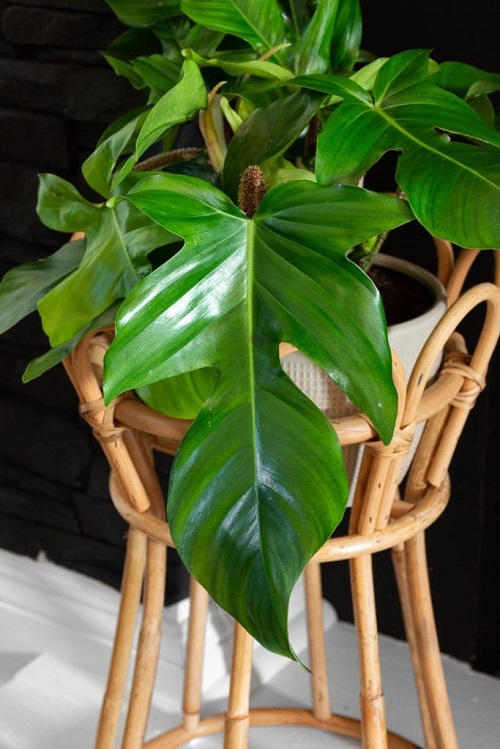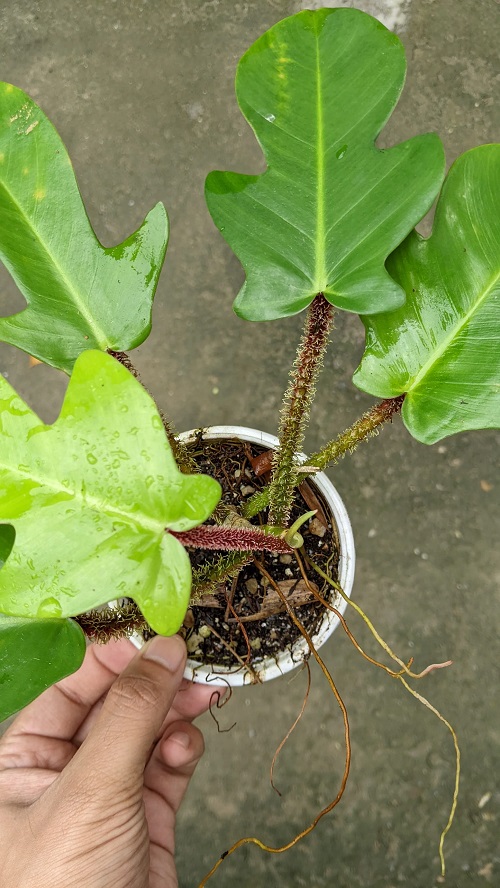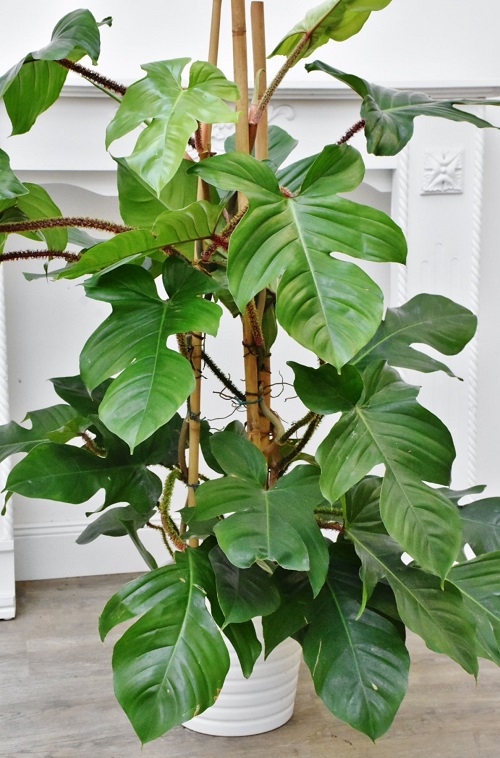Philodendron Squamiferum sports lush green and large leaves that can instantly add plenty of appeal indoors! Here’s how to grow it.

If you want to learn how to grow Philodendron Squamiferum, this guide will provide you with easy-to-follow steps and tips. From planting to care instructions, you’ll discover everything you need to know to nurture and enjoy this unique and beautiful plant.
Read about Philodendron Green Dragon Care and Growing Guide here
Philodendron Squamiferum Information
The Philodendron Squamiferum, also popular as the red bristle philodendron, displays mature vines adorned with impressive, dark green foliage. The stems of this plant, called petioles, develop a reddish hue as they mature, adding to its visual appeal.
Philodendron squamiferum is a climbing or trailing plant with distinctive features. It has elongated, heart-shaped leaves that are usually about 4 to 8 inches long. The leaves have a glossy dark green color on the upper surface and a lighter green shade on the underside.
One of the most notable characteristics of Philodendron squamiferum is the presence of long, reddish-brown bristles or hairs that cover the petioles (leaf stems) and the veins on the undersides of the leaves. These bristles give the plant a unique and interesting texture.
Read Philodendron Strawberry Shake Care and Growing Information
Propagating Philodendron Squamiferum
Stem cutting is the easiest way to grow Philodendron squamiferum. However, you can also propagate it using air layering.
- Select a healthy stem with at least two nodes (points where leaves emerge) from the parent Philodendron squamiferum.
- Using a clean, sharp knife or pruning shears, make a clean cut just below a node.
- Remove any lower leaves, leaving only a few at the top.
- Optionally, you can dip the cut end in a rooting hormone to promote root development.
- Place the cutting in a jar or container filled with water, making sure that the nodes are submerged.
- Keep the Philodendron Squamiferum cutting in a warm and bright location, avoiding direct sunlight.
- Change the water every few days to prevent stagnation.
- Roots should start developing within a few weeks. Once the roots are about an inch long, you can transfer the cutting into a pot with well-draining soil.
Check out Dragon Tail Philodendron Care Tips and Tricks here
Requirements for Growing Philodendron Squamiferum
Light
To provide the ideal lighting conditions, it is recommended to place your Philodendron squamiferum a few feet away from a south or west-facing window. This positioning allows the plant to receive bright, indirect light, which is optimal for its growth and foliage.
If you have no other option but to position the plant near a sunny south-facing window, it is advisable to use a sheer curtain to filter the incoming light. This way, the curtain acts as a shield, reducing the intensity of the sunlight and ensuring that Philodendron Squamiferum receives the desired level of indirect light.
Soil
An ideal potting mix for Philodendron squamiferum can be achieved by combining equal parts orchid bark, perlite, and peaty soil. This blend ensures proper aeration and drainage for the roots.
Find out some Helpful Hacks to Improve Your Garden Soil for Free here
If necessary, you can also incorporate some gravel into the mix to further enhance drainage capabilities. Alternatively, there are pre-made commercial aroid mixes available in the market that can be suitable for this plant.
Water
Philodendron squamiferum is not entirely drought-tolerant, but it can handle occasional delays in watering without major issues. However, overwatering is a common cause of problems for this plant.
Here are Signs of Overwatering & How to Save an Overwatered Plant
Philodendron squamiferum does not appreciate having consistently wet soil, as it can lead to root rot and attract pests.
A simple way to determine when to water is by inserting a finger into the soil. It is best to wait until at least the top few inches of the soil feel fully dry before watering the plant again.
Temperature and Humidity
Philodendron squamiferum prefers temperatures between 65°F (18°C) and 90°F (32°C). Do not expose the plant to temperatures lower than 10 C.
The plant is sensitive to cold drafts, so it’s crucial to keep it away from areas where cold air may be present, such as drafty windows, doors, or air conditioning vents. Sudden drops in temperature can adversely affect the plant’s growth and overall health.
Given its tropical origins, Philodendron squamiferum prefers higher-than-average humidity levels indoors. To increase humidity, you can consider using a humidifier, grouping it with other plants that have similar humidity requirements, or placing its container on top of a tray filled with water and pebbles.
Here are 10 Ways To Increase Humidity For Houseplants That Work
Philodendron Squamiferum Care

Fertilizer
Philodendron squamiferum is a slow-growing plant that doesn’t require heavy feeding. Use a well-balanced, water-soluble houseplant fertilizer with a ratio such as 20-20-20 or 10-10-10. Dilute it to 1/2 of its strength and use it every two to four weeks.
Reduce or stop fertilizing during the dormant period in winter when the plant’s growth slows down.
Here are Effective Homemade Lawn Fertilizers That Are Safe From Hazardous Chemicals
Pruning
Although the Philodendron squamiferum is a slow-growing plant, mature specimens can grow to a considerable height. To maintain a more compact, full, and bushy form, regular pruning or pinching back is recommended.
By removing excess growth and trimming the plant, you can encourage branching and create a denser appearance.
If you desire a tall, vining plant, it is advisable only to remove dead or dying leaves during pruning. This allows the plant to retain its natural growth habit while ensuring that it remains healthy and vibrant.
Pests and Diseases
Fortunately, Philodendron squamiferum is generally resistant to many diseases, and pests are not usually a significant concern. However, one common pest issue that may arise is fungus gnats, which are often associated with overwatering.
To prevent or address this problem, it is important to avoid overwatering the plant and ensure that the soil has proper drainage.
On the other hand, underwatering and dry conditions can attract spider mites. If you notice signs of spider mites, such as webbing or tiny pests on the leaves, you can take action to control them.
Look out for these Sure Shot Signs of Underwatered Plants
One effective method is to spray the plant with water to create a moist environment and then wipe away the pests using insecticidal soap or neem oil, which are effective natural treatments for spider mites.



